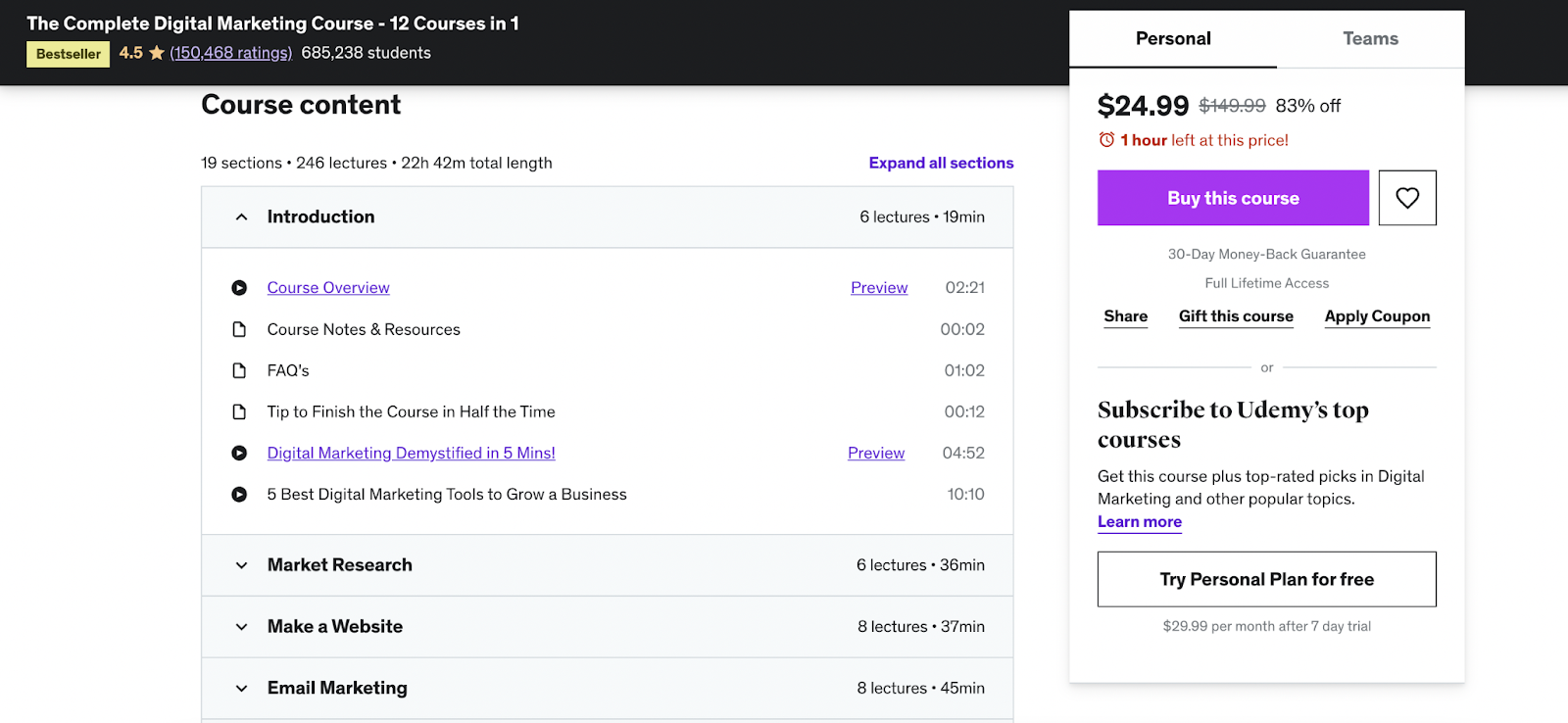If there is no student engagement, it is a waste of time for both students and the instructor. It also makes everyone tired and annoyed.
The teaching process turns into screaming into the void and feeling of being a failure. The process of learning feels like a tiresome duty that demotivates students.
At the same time, if the students are highly engaged, you can expect 12% higher achievement during the course. You may also notice that you enjoy your job a little bit more and notice that fewer students drop out and some of them even invite their friends and colleagues.
So how do you avoid the sad picture at all times? Let’s take a closer look at what student engagement is and learn seven tips on how to increase student engagement in online learning.
What is online student engagement?
Student engagement describes the level of attention, curiosity, interest, optimism, and passion that a student shows during the learning process.
The engagement may take many forms. For example, students can take notes, listen actively, ask and respond to questions, make effort during individual or group activities, and reach out to the instructor to ask for more resources or extra tasks.
At the same time, the motivation behind these actions should not be good grades but a real interest in things that you teach.
The term has grown in popularity in recent years. Instructors have shifted their focus from the knowledge they give to the student who receives that knowledge. They know that everyone can find different kinds of information on the internet, so they changed their purpose.
Now their main aim is to make the person enjoy the process of learning, make students more interested in what they are learning, and give them excitement and inspiration over. That is something you can achieve with student engagement.
Engaged learners would be better at grasping your material which means that they would be more satisfied with your course and would be more likely to leave positive reviews.
Take a look at our recent blog post on how to start a profitable eLearning business from scratch!
Types of student engagement in online learning
There are three types of student engagement you should know about:
- Behavioral. Behavioral engagement is about students’ participation: they are always on time, have needed materials and finished homework, and answer questions. You can notice those by just watching out for students’ behavior.
- Cognitive. Cognitive engagement is about being eager to learn: students ask questions and look for more resources to dive into some topics deeper. You can measure cognitive engagement by looking at students’ behavior or asking them directly what was the last topic they were into and trying to learn more about.
- Emotional. Emotional engagement means enjoying the educational experience and having a positive relationship with the instructor and other students. You can measure this by conducting an anonymous survey. You are more likely to get genuine answers if you allow a third party to collect and analyze results.
It is important to take care of all three types of engagement. Sometimes students can be interested in learning but have a negative outlook on learning with you. In some cases, students seem to be very participative, but they don’t actually care about the knowledge they get and can forget it as soon as they get some kind of gratification.
Actionable ways to increase online student engagement
It is even more difficult to engage your students in the online dimension. They are very likely to do something in parallel and distract themselves regularly. It is understandable because it is more difficult to focus when it is just some picture talking to you from the screen.
Check our post to learn about 10 popular webinar platforms, each with specific features that could boost students’ engagement.
There are numerous ways to increase student engagement in online learning. You can use all of these tips or a combination of them. We have put them in a list where the higher the tip is, the more essential it is and needs to be implemented as soon as possible.
Let students know what to expect
If a person has a plan and knows what to do, they will at least try to do something. It is essential to explain to students what they will learn, write down assignment deadlines, make this data accessible at all times, and explain what platforms you will work with. Make sure to follow the same structure for all lessons to make classes more organized.
This is one of the most basic student engagement strategies for the online learning environment. Otherwise, learners are likely to miss the assignments or have issues with the platforms. They will become angry and confused and may see you as a disorganized person they don’t need to listen to. It is easy to lose respect in such situations.
For example, while taking the course on Udemy, students can see in detail what they will be working on and how much time they need to allocate to each course section.
 Course content on Udemy that educates students on what to expect from the course
Course content on Udemy that educates students on what to expect from the course
Let students find solutions
It was common for instructors to read lessons and let students consume them without question. However, these times have changed. It is highly recommended not to spoonfeed knowledge but let students come to their solutions.
This method doesn’t only engage students but also encourages them to think and be creative rather than passively listen. It is much more interesting to make small discoveries on your own rather than listen to the findings of others. It trains logic too.
So you can give basic concepts, ask them questions on more complex situations, give case studies, and let them create experiments.
Use different content formats
Students will become bored in no time if it is just presentations with text. An average attention span has decreased from 12 seconds to 8 seconds. Therefore, we recommend using audio, videos, or images to keep students engaged and interested. Images may come in the form of infographics or can be used for different types of interactive activities, for example, associations. You can use videos to let students know how to work with platforms, listen to speeches of experts on the lecture topic, or introduce short explainers.
Check our recent post to learn how to increase student engagement by utilizing educational infographics.
You can also send these materials after your lessons. It is also good to include articles or blog posts of experts. It will diversify the content of your course and encourage students to always look for more points of view and sources of information.
Adding infographics to your course is also a creative and effective way to structure the material and increase students’ engagement.
 An example of an infographic that can increase students’ engagement; source: The Balance
An example of an infographic that can increase students’ engagement; source: The Balance
Add interactive activities
If you talk for the entire lesson, there will be no engagement. Students could have listened to a random video on the internet and had the same result.
The most basic one can and must do is a Q&A session at the end of each block of the information or at least at the end of a lesson. It will help you understand where your lesson lacks explanations and where you need to add more details, so students gain deeper knowledge. You can also allow students to answer questions to make it even more interactive.
It is important to create breakout rooms for group discussions and presentations. It will give students, especially shy ones, an opportunity to speak more freely and think and voice their opinions rather than just passively listen.
You can also add quizzes or create small anonymous polls to test the knowledge or collect feedback.
Add healthy competitiveness by gamification
Healthy competitiveness is also sometimes called gamification of learning. According to research, 67.7% of students consider gamified learning more motivating and engaging than traditional learning. It is important to highlight individual students’ achievements and also encourage underperforming students not to give up.
It is due to the fact that you create some kind of leadership board and give badges or points for different achievements. This method also works for adults: just look at the success of Duolingo’s Leaderboard and how they motivate students to keep their streaks and complete more lessons than they intended. This feature of Duolingo allows users to aggregate points for performing specific tasks, and then the points collected make users rank higher on the Leaderboard.
 Duolingo’s Leaderboard as a gamified element increasing student engagement; source: Duoplanet
Duolingo’s Leaderboard as a gamified element increasing student engagement; source: Duoplanet
Engage students during video lessons with live reactions
Many video platforms used by online educators allow participants of a video call to add such reactions as thumbs up or down, applauses, emojis, etc. Students can instantly show this reaction right next to their face, so an educator can evaluate how the information is being perceived.
Create communities and chats
Education happens outside of the online classroom as well, and it is important to spread this message. You can create forums, communities, and chats to encourage curiosity and discussion and create a safe space for questions.
To keep the communities alive, you can add open questions for discussions and polls and add materials we discussed earlier.
See the example of the group discussion on Coursera, where students can get to know each other, ask questions and share their insights.
 Discussion forum for online learning on Coursera
Discussion forum for online learning on Coursera
Conclusion
Creating an online course is one thing, and keeping people interested in it is the other. If you just read out presentation slides, you won’t only discourage current students but may never get new ones.
At the same time, keeping students engaged is not that difficult; you just need to be passionate about your topic. It means that you need to be actively present by answering and asking questions and researching outside of the classroom, adding more interactive platforms, and managing communities. Be the change you want to see in others, as the saying goes.
Consider using our online course creator, an advanced platform that allows you to create interactive landing pages, utilize various content forms, and leverage multiple other features that would increase online student engagement. You can also run tests to evaluate your teaching approaches’ effectiveness and find those that bring the most value to your students.